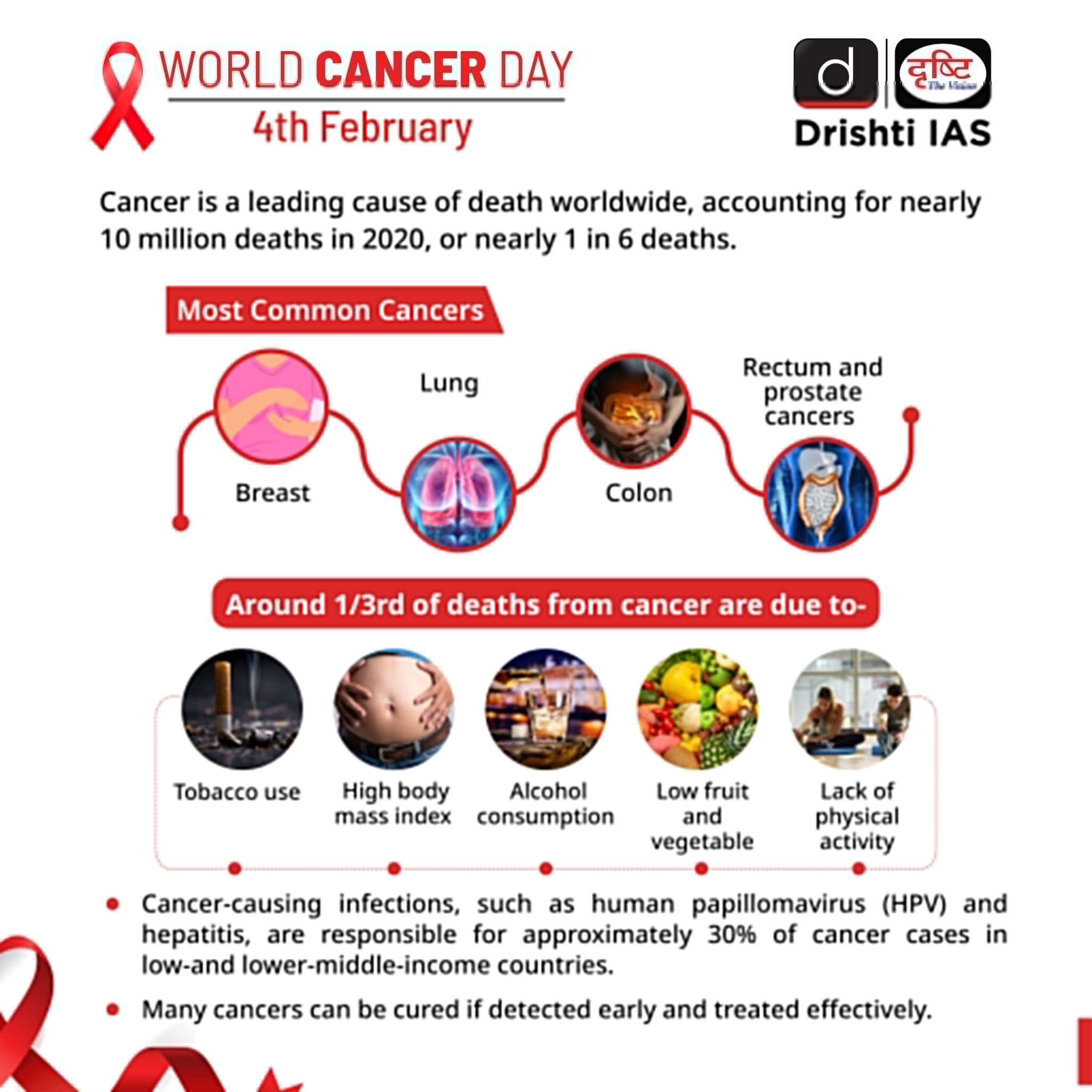Debate on Making Cancer a Notifiable Disease | 19 Mar 2025
For Prelims: Cancer, World Health Organization, National Cancer Registry Program, Cervical cancer
For Mains: Public Health Policies in India, Disease Notification in India, Cancer Prevention
Why in News?
There are growing calls to make cancer a notifiable disease in India, but the Union government resists, citing its non-communicable nature.
- The inclusion of snakebites as a notifiable disease (2024) and global precedents like the US listing lead poisoning (1995) as notifiable disease challenges this reasoning, prompting a re-evaluation of India’s stance on cancer notification.
What is Notifiable Disease in India?
- About: A notifiable disease is one that must be legally reported to government authorities by healthcare providers for real-time epidemiological tracking, resource allocation, and early intervention.
- The Epidemic Diseases Act, 1897 governs the notification and regulation of epidemic disease (rapid spread of disease to a large number) reporting.
- The World Health Organization (WHO) mandates notification for certain diseases to aid in global disease surveillance and control.
- Examples: Infectious diseases like tuberculosis, malaria, and Covid-19 are typically notifiable due to their potential to spread.
- However, the Ministry of Health and Family Welfare (MoHFW) classified snakebite as a notifiable disease, despite it being non-communicable.
What is the Debate on Classifying Cancer as a Notifiable Disease?
Arguments in Favor
- Better Data Collection: The National Cancer Registry Program (NCRP), covering only 16% of India’s population, lacks comprehensive data, drawing criticism from a parliamentary committee, highlighting the need for improved tracking.
- With enhanced data nearly 50% of cancer deaths are preventable by controlling risk factors like smoking, air pollution, and asbestos exposure.
- Some cancers, like cervical cancer, are linked to human papillomavirus (spreads through contact), prompting experts to propose classifying cancer as a “documentable disease” for mandatory data collection.
- Making cancer notifiable would ensure real-time data on incidence, prevalence, and mortality rates can be prevented by controlling risk factors like tobacco, air pollution, and carcinogenic chemicals.
- Indian States Approach: 17 states have made cancer notifiable through administrative orders, highlighting the need for a national-level mandate.
- States with high cancer incidence, like Kerala and Mizoram, could benefit from mandatory notification for better intervention.
- Global Precedents: Countries like Australia have made cancer notifiable, while the United Kingdom mandates cancer registration, in contrast, India’s NCRP registration remains voluntary.
Arguments Against
- Non-Communicable Nature: Unlike infectious diseases, cancer is not contagious or an immediate public health threat, making mandatory notification unnecessary.
- Privacy Concerns: Notifiable diseases prioritize public health over individual privacy, which may deter people from seeking diagnosis.
- Cancer carries social stigma, and legal obligations to report cases could reduce patient willingness to seek timely treatment.
- Burden on Healthcare Providers: Physicians may face unnecessary legal burdens if notification is made mandatory.
- Cancer requires personalized long term treatment, and notifiability is typically used for emergency containment, not long-term diseases.
India’s Existing Cancer Surveillance Mechanism
- The NCRP under Indian Council of Medical Research (ICMR), tracks cancer demographics, diagnosis, treatment, and survival through Hospital-Based (HBRs) and Population-Based Registries (PBRs).
- As of 2022, India has 269 HBRs and 38 PBRs, but coverage remains inadequate.
- In 2023, over 14 lakh cancer cases were reported, with 100 per 1 lakh people diagnosed.
What Should India Do to Strengthen Cancer Surveillance?
- Phased Notification Approach: Classify high-risk cancers like cervical and lung cancer as “documentable diseases” for mandatory data collection.
- Integrate Digital Health Technologies: Link cancer data collection with the Ayushman Bharat Digital Mission (ABDM) to create a centralized cancer registry.
- Integrate cancer screening records with CoWIN-like platforms to ensure targeted follow-ups and treatment adherence.
- Cancer Reporting: Increase the number of PBRs to expand cancer testing and related facilities nationwide, and implement universal screening for high-risk cancers.
- Empower local health workers (like Accredited Social Health Activists) to actively report cancer cases and conduct door-to-door awareness campaigns.
- Expand cancer coverage under Pradhan Mantri Jan Arogya Yojana and increase insurance support, as treatment is long-term and costly.
- This will enable free screening for low-income families, ensuring financial barriers do not delay diagnosis and treatment.
- Reduce Stigma: Partner with spiritual leaders, influencers, and media icons to destigmatize cancer reporting and normalize screenings.
- Promote cancer survivors as “ambassadors”, sharing their stories to inspire early detection and eliminate fear surrounding the disease.
|
Drishti Mains Question: Discuss the merits and challenges of making cancer a notifiable disease in India. Should India adopt a national-level mandatory cancer reporting system?. |
UPSC Civil Services Examination, Previous Year Questions (PYQs)
Prelims
Q. With reference to the treatment of cancerous tumours, a tool called cyberknife has been making the news. In this context, which one of the following statements is not correct? (2010)
(a) It is a robotic image guided system
(b) It delivers an extremely precise dose of radiation
(c) It has the capability of achieving sub-millimetre accuracy
(d) It can map the spread of tumour in the body
Ans: (d)
Q. ‘RNA interference (RNAi)’ technology has gained popularity in the last few years. Why? (2019)
- It is used in developing gene-silencing therapies.
- It can be used in developing therapies for the treatment of cancer.
- It can be used to develop hormone replacement therapies.
- It can be used to produce crop plants that are resistant to viral pathogens.
Select the correct answer using the code given below.
(a) 1, 2 and 4
(b) 2 and 3
(c) 1 and 3
(d) 1 and 4 only
Ans: (a)
Mains
Q. “Besides being a moral imperative of a Welfare State, primary health structure is a necessary precondition for sustainable development.” Analyse. (2021)
Q. Appropriate local community-level healthcare intervention is a prerequisite to achieve ‘Health for All’ in India. Explain. (2018)

